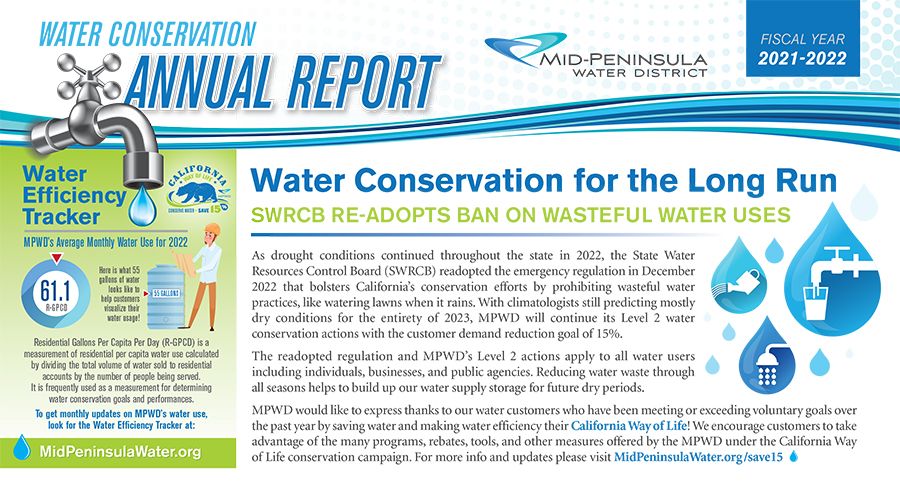Official Documents & Reports
- Consumer Confidence Report (CCR)
- Urban Water Management Plan (UWMP)
- Water Conservation Annual Report
- MPWD Policy Manuals
- Water Capacity Charges Update
- Finance Plans & Rate Studies

Since 1929, the MPWD has provided safe, high quality, and reliable water to its customers. We are pleased to report in the 2024 Consumer Confidence Report (CCR) that the MPWD once again met and surpassed all federal and state water quality regulations.
AVAILABLE FOR DOWNLOAD AS PDF
Your satisfaction is our top priority. Please contact us with any questions or concerns.
To view a past CCR, select a year below:
2020 Urban Water Management Plan
The UWMP Act (CA Water Code §§10608-10656) requires MPWD to update its UWMP every 5 years
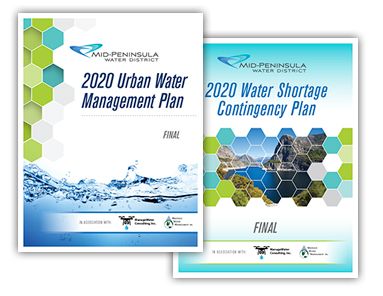
The Mid-Peninsula Water District (MPWD) has adopted its 2020 Urban Water Management Plan (UWMP). The UWMP will be effective for five years through 2025. The plan also includes a updated Water Shortage Contingency Plan (WSCP).The intent of the UWMP is to provide the Department of Water Resources (DWR) and the general public with information on present and future water supply and demand and to provide an assessment of water resources needed. It also serves the purpose of helping ratepayers better understand our water system, service area, water reliability and contingency planning.
DOWNLOAD THE FINAL 2020 UWMP HERE (PDF)
DOWNLOAD THE FINAL 2020 WSCP HERE (PDF)
DOWNLOAD THE FINAL 2020 UWMP APPENDICES HERE (PDF)
Urban Water Management Plans (UWMPs) are prepared every five years in accordance with the California Water Code. The purpose of the UWMP is to:
- Assess water supplies and demands over a 25-year planning time frame.
- Describe demand management measures.
- Report progress toward meeting targeted reductions in per-capita use.
- Discuss alternative water supplies.
- Develop and adopt a Water Shortage Contingency Plan.
UWMP & WSCP Schedule
Public Virtual Hearings – 2020 UWMP & WSCP
All interested parties were invited to attend both public hearings and present oral or written views. The first public hearing was held June 24, 2021 (video recording available here). The second public hearing was held July 22, 2021 (video recording available here).
What Is an UWMP?
An UWMP is the legal and technical water management foundation for suppliers throughout California. The MPWD’s UWMP provides its staff, the public, and elected officials with an understanding of past, current, and future water conditions and management. This UWMP integrates local and regional land-use planning, regional water supply, infrastructure, and demand management projects, as well as statewide issues of concern like climate change and regulatory revisions. For its 2020 UWMP, the MPWD gathered, characterized, and synthesized water-related information, including using local, regional, and statewide sources. The intent of the UWMP is to provide the California Department of Water Resources (DWR) and the public with information on present and future water sources and system demands and to provide an assessment of MPWD’s water resource needs.

The original UWMP Act, signed into law in 1983, requires an urban water supplier that provides water for municipal purposes to more than 3,000 customers, or serving more than 3,000 acre feet annually, to adopt an UWMP every five years demonstrating water supply reliability in normal, single dry, and multiple dry years for a 20-year planning period. lt also must identify and quantify the adequacy of water supplies for existing and future demands during normal, dry and drought years, and assure efficient use of urban water supplies. The Act also requires water shortage contingency planning and drought response actions.
The 2020 UWMP has undergone significant expansion and revision. Prolonged droughts, groundwater overdraft, regulatory revisions, and changing climatic conditions not only affect a supplier’s water reliability determinations, but also the broad picture of statewide water reliability overseen by the DWR, the State Water Resources Control Board, and the State of California Legislature.
Numerous additional requirements were added by the DWR for 2020 UWMPs since the last plan document in 2015. Key new requirements include:
- Five Consecutive Dry-Year Water Reliability Assessment
- Drought Risk Assessment
- Seismic Risk
- Climate Change Considerations
- Groundwater Supplies Coordination
- Layperson’s Description
What Is an WSCP?
The Water Shortage Contingency Plan (WSCP) serves as a “stand alone” preparedness and response plan for the MPWD, not only during water shortage conditions, but before and after as well. lt includes specific actions for management of the MPWD’s water supply and demand, addresses the impacts associated with water shortages, and facilitates the timely implementation of effective contingency responses.
MPWD's UWMP & WSCP
The MPWD is a California Special District and a public agency directly providing water for municipal purposes since 1929. The MPWD serves 27,560 customers and has 8,111 service connections. As defined in Water Code Section 10617, MPWD qualifies as an “urban water supplier” and is required to complete an UWMP for 2020. This is the seventh UWMP prepared by the MPWD.The 2020 UWMP updates MPWD’s previous 2015 UWMP that was submitted to DWR on July 1, 2016. MPWD’s comprehensive urban water management planning process integrates information about supply and demands to address short- and long-term water planning. ln so doing, the MPWD:
- Assesses changes in natural hydrology, climate, and groundwater conditions.
- Anticipates the implications of regional, state, and federal regulations.
- Understands supply conditions and water use variability.
- ldentifies regional constraints on or opportunities for shared water resources.
- lntegrates local land-use changes, development, plans, and population growth.
- Prepares for water shortages and unforeseen calamities.
- Anticipates infrastructure vuInerabiIities and plans mitigation measures.
- Recognizes project funding needs and opportunities.
For its 2020 UWMP, the MPWD added the most current data to ensure its 2020 UWMP continues to be its go-to reference for reliable information about its water system and water management. The MPWD 2020 UWMP is an important resource for the MPWD staff, management, the Board of Directors, and its customers. The 2020 UWMP addresses the following MPWD’s water-planning fundamentals:
- A detailed review of current and future water use.
- Evaluation of potable and potential non-potable water supplies.
- Analysis of water supply reliability by the SFPUC under normal conditions, single dry-year conditions, and five consecutive dry years through at least 2040.
- A realistic Drought Risk Assessment by including the water supply and projected water use in a hypothetical five-year drought; and
- An effective and practical Water Shortage Contingency Plan that specifies opportunities to reduce demand and augment supply under various and unpredictable water shortage conditions.
Potential Impacts on SFPUC Water Supply Reliability
On December 12, 2018, the SWRCB adopted amendments to the Water Quality Control Plan (WQCP) for the San Francisco Bay/Sacramento-San Joaquin Delta Estuary (Bay-Delta Plan or BDP) to establish objectives to maintain the health of the Bay-Delta ecosystem. It was developed with the stated goal of increasing salmonid populations in three San Joaquin River tributaries (the Stanislaus, Merced, and Tuolumne Rivers), collectively known as the Bay-Delta. The plan requires the release of 30%-50% of the “unimpaired flow” (natural flow) on the three tributaries from February through June in every year type. In an extended multi-year, state-declared drought that could result in an almost 50% cutback in water supply to most customers served by the SFPUC, including the MPWD.
If the BDP is implemented, for normal years, the SFPUC would be able to meet the projected water demands of its wholesale customers (including the MPWD). However, without augmentation from other sources, the SPFUC expects it would experience supply shortages in single dry years and multiple dry years, and implementation of the BDP would require rationing.
Implementation of the BDP is uncertain for multiple reasons, including the proposition of several voluntary agreements by water suppliers, including the SFPUC, and lawsuits that have been filed in both state and federal courts challenging various aspects of the BDP.
Tuolumne River Voluntary Agreement
In response to the BDP, the SFPUC and the Modesto and Turlock Irrigation Districts have proposed the Tuolumne River Voluntary Agreement (TRVA), a combination of flow and non-flow measures sufficient to improve all life-stages of native fish populations in the lower Tuolumne River. The SFPUC has consistently stated that voluntary agreements are the best path forward for the Bay-Delta, as the voluntary agreement strikes the right balance between environmental stewardship and water reliability.
While the long-term voluntary agreement work continues, the SFPUC does not want to wait to restore the Tuolumne River’s ecosystem. In 2021, the SFPUC and the Modesto and Turlock Irrigation Districts launched a proactive pilot program with the U.S. Fish and Wildlife Service that provided an immediate $4 million investment for habitat improvements for fisheries in the Tuolumne River.
Why Is This Relevant to the MPWD’s 2020 UWMP & WSCP?
Due to the current uncertainty about the implementation of the Water Quality Control Plan (WQCP) for the San Francisco Bay/Sacramento-San Joaquin Delta Estuary (Bay-Delta Plan or BDP), in mid-January 2021 the SFPUC provided two contrasting scenarios of projected future water supplies — with and without the WQCP impacts. These projections were refined through mid-April 2021, and other alternatives modeled, during the development of the MPWD’s 2020 UWMP and WSCP. Like the majority of the RWS wholesale customers, the MPWD followed the lead of the SFPUC and used the two contrasting water supply scenarios. Below, please find a graph from MPWD’s UWMP that reflects the Drought Risk Assessment results of what a potential 50% cutback of water supply looks like.
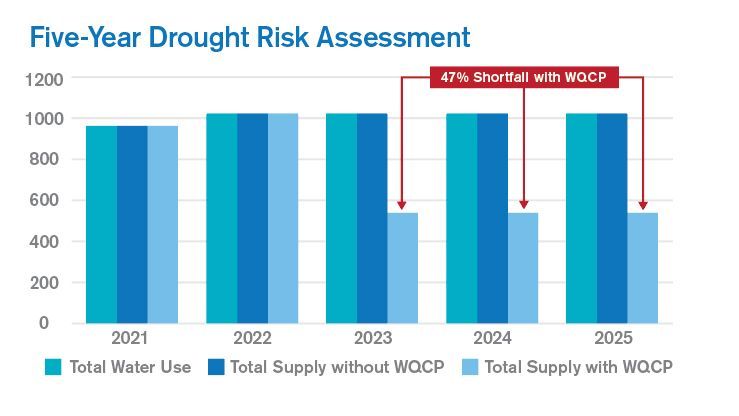
Water Shortage Levels of Action
The MPWD's WSCP contains six standard water shortage levels of up to 10-, 20-, 30-, 40-, 50-, and greater than 50-percent shortages. A systematic approach and framework were developed for the MPWD’s 2020 WSCP, which included the necessary flexibility for MPWD and practical, initial voluntary conservation levels, followed by mandatory water rationing in response to increasingly severe water shortages. MPWD’s shortage levels align with its response actions that will be implemented to meet the severity of future shortages.
Shortage Level 0 – Shortage Range 0%: NORMAL: Condition exists when MPWD notifies its water users that no supply reductions are anticipated.
Shortage Level 1 – Shortage Range >0-10%: Water Supply Shortage: Condition exists when the MPWD notifies its water users that due to drought or other supply reductions, a consumer demand reduction of up to 10% is necessary. ***MPWD is currently at Level 1***
Shortage Level 2 – Shortage Range >10-20%: Water Warning: Condition exists when MPWD notifies its water users that due to drought or other supply reductions, a consumer demand reduction of up to 20% is necessary.
Shortage Level 3 – Shortage Range >20-30%: Water Restricted: Condition exists when MPWD declares a water shortage restricted condition pursuant to California Water Code section 350 and notifies its residents and businesses that up to 30% consumer demand reduction is required.
Shortage Level 4 – Shortage Range >30-40%: Water Crisis: Condition exists when MPWD declares a water shortage emergency condition pursuant to California Water Code section 350 and notifies its residents and businesses that up to 40% consumer demand reduction is required.
Shortage Level 5 – Shortage Range >40-50%: Water Emergency: Condition exists when MPWD declares a water shortage emergency condition pursuant to California Water Code section 350 and notifies its residents and businesses that up to 50% consumer demand reduction is required.
Shortage Level 6 – Shortage Range >50%: Extreme Emergency: Condition exists when MPWD declares a water shortage emergency condition pursuant to California Water Code section 350 and notifies its residents and businesses that greater than 50% consumer demand reduction is required.
Consecutive dry years may necessitate drastic actions enacted by agency for Level 6 Extreme Emergency. Possible water conservation measures may include: Gallons Per Capita Per Day (GPCD) consumption limits; water use for indoor public health and safety purposes only; ban on ALL outdoor irrigation; water budgets; net-zero demand on new connections; emergency rate adjustments; fines and/or penalties; prohibitions on pool filling, car washing, other outdoor uses; operational changes.
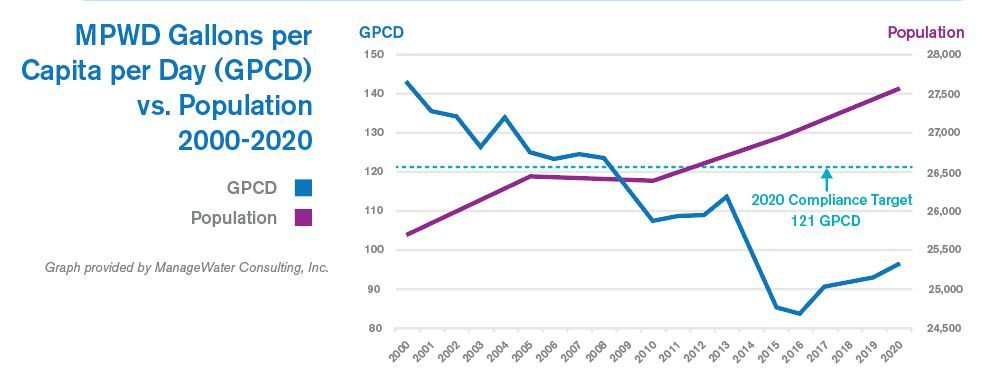
California Way of Life Legislation
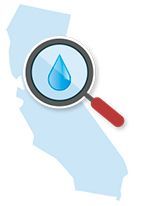
DISCUSSION: DWR, in coordination with the SWRCB, shall partner in conducting the necessary studies and investigations to develop recommendations and report back to the Legislature on the all standards, variances, objectives, etc.
Learn More! Explore additional resources for topics covered above.
- California Special Districts Association
- Bay Area Water Supply & Conservations Agency
- San Francisco Public Utilities Commission – 2020 UWMP & WSCP
- SFPUC – Tuolumne River Watershed
- Making Conservation a California Way of Life
- California Department of Water Resources
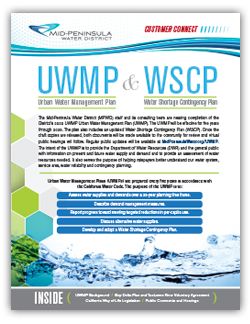
An explainer brochure for the 2020 UWMP and WSCP was mailed out to all MPWD rate payers in June, 2021, prior to the first virtual hearing. For a digital copy of this brochure, please download here (PDF).
MPWD's Water Conservation Annual Report is a comprehensive accounting of MPWD’s annual efforts, including achievements, rebate programs, reporting on the State Water Resources Control Boards (SWRCB) and Bay Area Water Supply and Conservation Agency (BAWSCA), community outreach and education, and MPWD's own water conservation efforts.
Financial Management Policy Manual
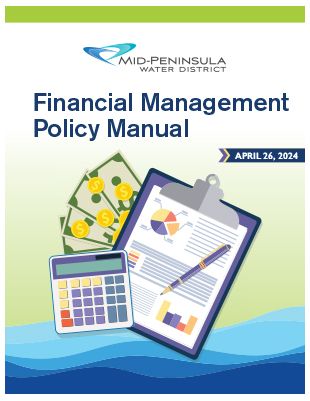
The Mid-Peninsula Water District is governed by the provisions of the California Water Code Sections 30000-33901. This Financial Management Policy will provide a comprehensive guide on the conduct of the MPWD’s financial affairs and is intended to provide an overview of the financial management, accounting, and internal control policies to ensure the MPWD’s compliance with prudent and financial management standards.
Its further purpose is to ensure that MPWD assets are safeguarded, that financial statements are in conformity with Generally Accepted Accounting Principles (GAAP), as established by the Governmental Accounting Standards Board (GASB), and that MPWD follows best practices to ensure finances are managed with responsible stewardship.
Download the MPWD Financial Management Policy Manual here (PDF)
Records Management Policy Manual
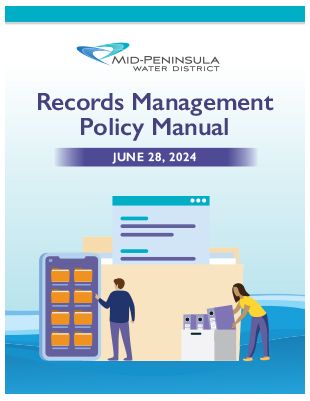
It is the policy of the Mid-Peninsula Water District to properly manage the retention and disposition of District records. Proper management of District records ensures prompt and accurate retrieval of records and compliance with legal and regulatory requirements, as well as minimizes the use of District resources for storage of records that are no longer needed.
This policy applies to all District employees, elected or appointed officials, contractors, vendors, temporary personnel, volunteers, or anyone creating or using District records.
Management of District records applies to all records in any format (paper, electronic) or location (on-site, off-site, in District vehicles, on District computers, laptops, tablets, and other electronic devices).
Download the MPWD Records Management Policy Manual here (PDF)
Personnel Manual
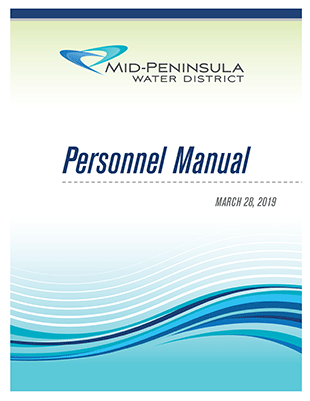
The Mid-Peninsula Water District is governed by the provisions of the California Water Code Section 30000 et seq. (and following) sections. Under the Water Code, the MPWD General Manager has authority to employ and discharge an employee at any time, with or without cause.
The language used in the MPWD Personnel Manual is not intended, nor is it to be construed, to constitute a contract between the MPWD and any employee or the public. The MPWD may add, modify, or delete any provision contained in this manual, including those concerning employee benefits, at any time with or without notice.
This Personnel Manual replaces and supersedes all personnel manuals, revisions, and amendments previously adopted by the MPWD.
Download the MPWD Personnel Manual here (PDF)
MPWD Personnel Manual History:
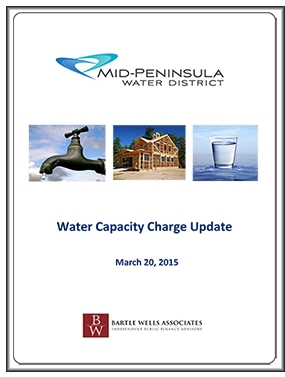
Water Capacity Charges Update
MPWD levies an Existing Facilities Charge on new or expanded connections as a condition of development. This charge was established to recover the cost of capacity in District facilities benefitting new development. The current fee was adopted in 1993 and has not been updated in over 20 years. This report refers to this type of development impact fee as a “capacity charge,” in line with terminology used in California Government Code. New connections also pay a Meter Charge to recover the cost of the water meter and a Service Line Charge to pay for the District’s costs of installing the service line and making the physical connection to the water main.
Water Rate Update (May 18, 2018)
Download the complete Water Rate Update here (PDF)
Water Financial Plan & Rate Study (May 26, 2015)
The study develops long‐term financial projections and calculates new water rates designed to equitably recover the costs of providing service. The recommended rates are designed to meet the District’s operational and capital funding needs, comply with legal requirements, and be fair to all customers.
Download the complete Water Financial Plan & Rate Study here (PDF)
Water Finance & Rate Update (April 24, 2016)
A summary of key issues (water consumption and MPWD finances) as part of the ongoing MPWD Financial Plan and Rate Study.
Download the complete update here (PDF)
Ordinance No. 120
An Ordinance Amending Attachment A Regarding Rates and Charges to the Water Service Ordinance for The Mid-Peninsula Water District.


